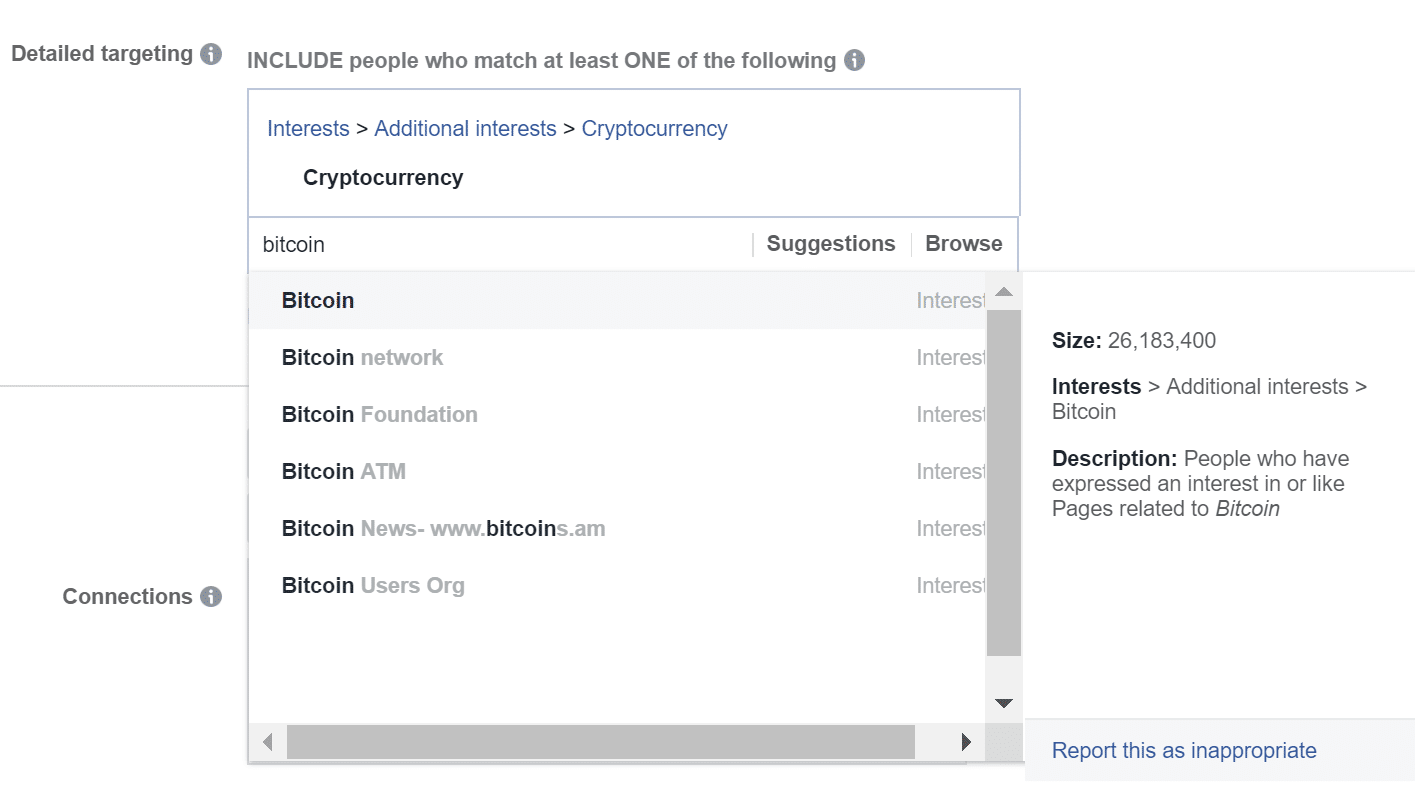As you can imagine, blockchain projects aren’t just trying to advertise their wares. Some blockchain projects are advertising tools themselves. What lies in the center of both topics is the idea of security and privacy.
And it makes sense. Privacy is currency these days. Facebook ads allow you to laser target users with identifiers as specific as age and your favorite movie. After the Cambridge Analytics scandal, worry over misuse of private data is more prevalent than ever.
Despite this, it’s crypto and blockchain projects that are getting the cold shoulder from advertising agencies. There’s a reason you didn’t get search ads for the 2,284 ICOs in 2018. Last year, the online advertising giants banned crypto and blockchain ads from their platforms.
Google and Facebook stressed it was for user protection. And maybe that’s true. After all, according to one study, 80 percent of ICOs that occurred in 2017 could be considered scams. In fact, the backlash was so strong, both platforms ended up compromising with a whitelisting process.
Crypto Ban’s Effect on the Market
It’s obvious that the crypto ban has impacted the growth of the blockchain market.
This blanket ban hinders education efforts to protect crypto users, and it prevents startups from amassing the public support they need to survive. In a way, the advertising ban has become a Catch-22. Because of it, blockchain projects can’t grow like a regular business, and their failure is considered a sign that the ban is the right choice.
Think about this: The bans arrived in the middle of 2018’s bearish trend. This action may not be the sole cause of the price drop, but it has negatively affected investor confidence. It was another factor contributing to the bears.
Yet, that doesn’t mean blockchain advertising on these platforms can be thrown completely out the window.
Blockchain Ads with Google
Google eased its full ban last year for Adwords with a whitelisting program, but it’s discretionary. While there is an application that must be approved for crypto advertising, you may not need it for your blockchain project.
Keywords containing blockchain aren’t necessarily banned, but they aren’t highly searched either. For example, a cursory look at Google Trends shows that the most searched terms are still “what is blockchain” and even simply “blockchain.” By using Keyword Planner, you can squeeze a bit more information in terms of volume and cost. Although, you will need to test each keyword to really get an idea if it works for you or not.

Facebook – Is It Worth It?
Like Google, Facebook has a strict ban on crypto and blockchain products. It’s so strict, that when even mentioning “hardware” in a boosted post, could cause it to be tagged as a crypto post! But maybe strict is the wrong word. In reality, Facebook bots don’t understand context, and the human reviewers aren’t necessarily trained in tech or finance.
You can try whitelisting your project on Facebook with this form, but the process is uncertain. It could take months to receive an answer. If you get one at all. According to Facebook:
“Please note that we reserve the right to deny any application or withdraw eligibility at any time without notice. Eligibility may be subject to such conditions and restrictions as Facebook may decide. Advertising must comply fully with all applicable terms and policies, including the Facebook Advertising Policies. Facebook may review and reject ads in its sole discretion”
If your product isn’t crypto-specific, you can target crypto users and people interested in blockchain tech. To make Facebook advertising work for you, with or without the whitelisting application, you’ll have to design a creative funnel that uses other industry pain points while targeting interested parties.

Of course, given Facebook’s track record with data privacy, you may want to avoid them altogether.
Everything You Need to Know About Blockchain Advertising
Blockchain advertising is tough but not impossible. In this trusty guide, we’ll take you through what you need to know to succeed in blockchain advertising.
Main Demographics
Who should you be marketing to? The broad audience for crypto and blockchain is easy to find. Crypto users are largely millennial, male, employed, and atheists. Furthermore, more than half are hitched or American. That would appear to narrow it down, right?
Those are only the general demographics. It is crucial to view your own project’s specific audience. Unless you’re creating a new exchange or crypto-centered project, it’s likely you have a whole other group to consider – those who aren’t on the blockchain but should be.
It’s always best to come up with two to three buyer personas that you can use when creating ads. This can include a persona for investors or types of users.
[thrive_leads id=’5219′]
Affiliate Marketing
One model of marketing that is effective is affiliate marketing. In other words, create an offer for users to bring others to your platform. Maybe it’s a discount or a coin bonus. This technique is effectively word-of-mouth for the campaign, but it can be an extremely useful and low-cost option.
The only issue? You need a functioning product and an engaged community.
Connecting to Industry Resources
In order to create the engaging community you need for affiliate or word-of-mouth marketing, you need to have an active plan to collaborate with thought leaders and leading publications.
This can mean advertising in top crypto websites, such as CoinTelegraph or CoinCentral (wink wink, nudge nudge). It can also mean creating threads and interacting on Bitcoin Talk, curating a Telegram group, and much more.
This is essentially a more traditional PR and advertising route, using crypto-friendly sources.
Blockchain Advertisers
That said, another way to leverage your blockchain brand is to advertise with other blockchain tools. There are blockchain advertising tools like NYIAX, an advertising contract trading platform that allows advertisers to reduce costs. Another project, BitClave, only shows users ads that deal directly with their search term. This approach is more user-friendly and again reduces costs for the advertiser.
Other projects like MadHive claim to be able to both validate and secure data from fraud, which is a definite plus. AdEx, an ad network based on Ethereum, also seeks to lower fraud and ad costs while expanding reach.
Finally, the Brave browser and it’s associated Basic Attention Token (BAT) implement numerous features to keep user data private while still helping advertisers target the right customers.
At the End of the Day
The blanket crypto ban is harming not just blockchain projects but also potential users of blockchain technology. If a startup can’t advertise, how can it grow? Or even more insidious, how can educational sites teach others about the technology and warn them of potential scams if they can’t reach the main population?
Despite all this, blockchain advertising is still possible, even on the major platforms. You just need to be a little creative.





